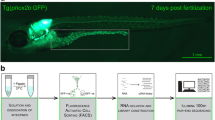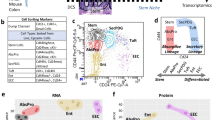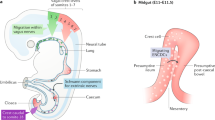Abstract
Background
Eph receptor tyrosine kinases EphB2 and EphB3, and ephrin-B1 ligand play a critical role in regulating small intestinal epithelial cell migration. Although well studied in developing brain, the expression pattern of Ephs/ephrins has not been delineated in the developing small intestine.
Aims
To examine the gene expression of all known members of Ephs/ephrins during development of mouse small intestine.
Methods
We examined the expression of 21 A- and B-Ephs/ephrins in mouse small intestine or the Caco-2 cell line using reverse-transcription polymerase chain reaction (RT-PCR), quantitative (q)RT-PCR, and immunohistochemical analyses. EphB2-expressing cells from isolated crypts were detected by immunofluorescence and fluorescence-activated cell sorting (FACS) analyses.
Results
With the exception of EphA5, all family members were expressed throughout the intestine at all ages examined. Most were uniformly expressed. In contrast, levels of EphA4, EphA8, EphB4, and ephrin-B2 messenger RNA (mRNA) were highest during early fetal development and declined with age. At E15, EphB2 and EphB4 proteins were diffusely expressed in proliferating stratified intestinal epithelial cells. By E18, the proteins had become localized to cell membranes of columnar epithelial cells within intervillus regions, and later were expressed on epithelial cell membranes in adult crypts. EphB2-expressing cells can be specifically isolated from crypt cell fractions.
Conclusions
The current study represents the first analysis of Ephs/ephrins during intestinal development. The elevated expression of EphA4, EphA8, EphB4, and ephrin-B2 during the fetal period of intestinal morphogenesis suggests an important role in development. Continued intestinal expression of other family members implicates a role in differentiation.




Similar content being viewed by others
References
Lhotak V, Greer P, Letwin K, Pawson T. Characterization of elk, a brain-specific receptor tyrosine kinase. Mol Cell Biol. 1991;11:2496–2502.
Jones TL, Karavanova I, Maeno M, Ong RC, Kung HF, Daar IO. Expression of an amphibian homolog of the eph family of receptor tyrosine kinases is developmentally regulated. Oncogene. 1995;10:1111–1117.
Scales JB, Winning RS, Renaud CS, Shea LJ, Sargent TD. Novel members of the eph receptor tyrosine kinase subfamily expressed during xenopus development. Oncogene. 1995;11:1745–1752.
Murai KK, Pasquale EB. ‘Eph’ective signaling: Forward, reverse and crosstalk. J Cell Sci. 2003;116:2823–2832.
Holland SJ, Gale NW, Mbamalu G, Yancopoulos GD, Henkemeyer M, Pawson T. Bidirectional signalling through the eph-family receptor nuk and its transmembrane ligands. Nature. 1996;383:722–725.
Davy A, Robbins SM. Ephrin-A5 modulates cell adhesion and morphology in an integrin-dependent manner. EMBO J. 2000;19:5396–5405.
Davy A, Gale NW, Murray EW, et al. Compartmentalized signaling by GPI-anchored ephrin-A5 requires the fyn tyrosine kinase to regulate cellular adhesion. Genes Dev. 1999;13:3125–3135.
Schmucker D, Zipursky SL. Signaling downstream of eph receptors and ephrin ligands. Cell. 2001;105:701–704.
Pandey A, Shao H, Marks RM, Polverini PJ, Dixit VM. Role of B61, the ligand for the eck receptor tyrosine kinase, in TNF-alpha-induced angiogenesis. Science. 1995;268:567–569.
Boyd AW, Lackmann M. Signals from eph and ephrin proteins: a developmental tool kit. Sci STKE. 2001; RE20.
Kullander K, Klein R. Mechanisms and functions of eph and ephrin signalling. Nat Rev Mol Cell Biol. 2002;3:475–486.
Frisen J, Holmberg J. Barbacid M: ephrins and their eph receptors. Multitalented directors of embryonic development. EMBO J. 1999;18:5159–5165.
Oike Y, Ito Y, Hamada K, et al. Regulation of vasculogenesis and angiogenesis by ephB/ephrin-B2 signaling between endothelial cells and surrounding mesenchymal cells. Blood. 2002;100:1326–1333.
Huynh-Do U, Vindis C, Liu H, et al. Ephrin-B1 transduces signals to activate integrin-mediated migration, attachment and angiogenesis. J Cell Sci. 2002;115:3073–3081.
Becker N, Seitanidou T, Murphy P, et al. Several receptor tyrosine kinase genes of the eph family are segmentally expressed in the developing hindbrain. Mech Dev. 1994;47:3–17.
Ganju P, Shigemoto K, Brennan J, Entwistle A, Reith AD. The eck receptor tyrosine kinase is implicated in pattern formation during gastrulation, hindbrain segmentation and limb development. Oncogene. 1994;9:1613–1624.
Patel K, Nittenberg R, D’Souza D, et al. Expression and regulation of Cek-8, a cell to cell signalling receptor in developing chick limb buds. Development. 1996;122:1147–1155.
Liebl DJ, Morris CJ, Henkemeyer M, Parada LF. mRNA expression of ephrins and eph receptor tyrosine kinases in the neonatal and adult mouse central nervous system. J Neurosci Res. 2003;71:7–22.
Mendes SW, Henkemeyer M, Liebl DJ. Multiple eph receptors and B-class ephrins regulate midline crossing of corpus callosum fibers in the developing mouse forebrain. J Neurosci. 2006;26:882–892.
Hafner C, Schmitz G, Meyer S, et al. Differential gene expression of eph receptors and ephrins in benign human tissues and cancers. Clin Chem. 2004;50:490–499.
Batlle E, Henderson JT, Beghtel H, et al. Beta-catenin and TCF mediate cell positioning in the intestinal epithelium by controlling the expression of ephB/ephrinB. Cell. 2002;111:251–263.
Cortina C, Palomo-Ponce S, Iglesias M, et al. EphB-ephrin-B interactions suppress colorectal cancer progression by compartmentalizing tumor cells. Nat Genet. 2007;39:1376–1383.
Holmberg J, Genander M, Halford MM, et al. EphB receptors coordinate migration and proliferation in the intestinal stem cell niche. Cell. 2006;125:1151–1163.
Takano-Maruyama M, Hase K, Fukamachi H, Kato Y, Koseki H, Ohno H. Foxl1-deficient mice exhibit aberrant epithelial cell positioning resulting from dysregulated ephB/ephrinB expression in the small intestine. Am J Physiol Gastrointest Liver Physiol. 2006;291:G163–G170.
Moore-Scott BA, Opoka R, Lin SC, Kordich JJ, Wells JM. Identification of molecular markers that are expressed in discrete anterior-posterior domains of the endoderm from the gastrula stage to mid-gestation. Dev Dyn. 2007;236:1997–2003.
Hauri HP, Sterchi EE, Bienz D, Fransen JA, Marxer A. Expression and intracellular transport of microvillus membrane hydrolases in human intestinal epithelial cells. J Cell Biol. 1985;101:838–851.
Pinto M, Robine-Léon S, Appay MD, et al. Enterocyte-like differentiation and polarization of the human colon carcinoma cell line Caco-2 in culture. Biol Cell. 1983;47:323–330.
Davies PS, Enns CA. Expression of the hereditary hemochromatosis protein hfe increases ferritin levels by inhibiting iron export in HT29 cells. J Biol Chem. 2004;279:25085–25092.
Islam S, Montgomery RK, Fialkovich JJ, Grand RJ. Developmental and regional expression and localization of mRNAs encoding proteins involved in RNA translocation. J Histochem Cytochem. 2005;53:1501–1509.
Weiser MM. Intestinal epithelial cell surface membrane glycoprotein synthesis. I. An indicator of cellular differentiation. J Biol Chem. 1973;248:2536–2541.
Pickles JO. Expression of ephs and ephrins in developing mouse inner ear. Hear Res. 2003;178:44–51.
Hafner C, Meyer S, Langmann T, et al. Ephrin-B2 is differentially expressed in the intestinal epithelium in crohn’s disease and contributes to accelerated epithelial wound healing in vitro. World J Gastroenterol. 2005;11:4024–4031.
Eph Nomenclature Committee. Unified nomenclature for Eph family receptors and their ligands, the ephrins. Cell. 1997;90:403–404.
Himanen JP, Chumley MJ, Lackmann ML, et al. Repelling class discrimination: ephrin-A5 binds to and activates EphB2 receptor signaling. Nat Neurosci. 2004;7:501–509.
Surawska H, Ma PC, Salgia R. The role of ephrins and eph receptors in cancer. Cytokine Growth Factor Rev. 2004;15:419–433.
Mills JC, Andersson N, Hong CV, Stappenbeck TS, Gordon JI. Molecular characterization of mouse gastric epithelial progenitor cells. Proc Natl Acad Sci U S A. 2002;99:14819–14824.
Wilkinson DG. Multiple roles of eph receptors and ephrins in neural development. Nat Rev Neurosci. 2001;2:155–164.
Mariadason JM, Nicholas C, L’Italien KE, et al. Gene expression profiling of intestinal epithelial cell maturation along the crypt-villus axis. Gastroenterology. 2005;128:1081–1088.
Barth JA, Li W, Krasinski SD, Montgomery RK, Verhave M, Grand RJ. Asymmetrical localization of mRNAs in enterocytes of human jejunum. J Histochem Cytochem. 1998;46:335–343.
Aasheim HC, Pedeutour F, Grosgeorge J, Logtenberg T. Cloning, chromosomal mapping, and tissue expression of the gene encoding the human eph-family kinase ligand ephrin-A2. Biochem Biophys Res Commun. 1998;252:378–382.
Dravis C, Yokoyama N, Chumley MJ, et al. Bidirectional signaling mediated by ephrin-B2 and ephB2 controls urorectal development. Dev Biol. 2004;271:272–290.
Saaf AM, Halbleib JM, Chen X, et al. Parallels between global transcriptional programs of polarizing Caco-2 intestinal epithelial cells in vitro and gene expression programs in normal colon and colon cancer. Mol Biol Cell. 2007;18:4245–4260.
Stappenbeck TS, Mills JC, Gordon JI. Molecular features of adult mouse small intestinal epithelial progenitors. Proc Natl Acad Sci U S A. 2003;100:1004–1009.
Kim BM, Mao J, Taketo MM, Shivdasani RA. Phases of canonical wnt signaling during the development of mouse intestinal epithelium. Gastroenterology. 2007;133:529–538.
Acknowledgments
We would like to thank Dr. Stephen D Krasinski (Division of Gastroenterology and Nutrition, Children’s Hospital Boston, Boston, MA) for statistical analysis of EphB4 expression data, NanaYaa Baffour-Awuah for technical help in qRT-PCR experiments, Sacha de Stoppelaar for maintaining Caco-2 cell-lines, and Dr. Daniel J Liebl (University of Miami, FL) for providing primer sequence for EphB3/B4. We thank Ms. Suzanne White (Histology Core, Harvard Digestive Disease Center, Boston, MA) for preparation of paraffin-embedded tissue sections. Grant Sponsor: NIH Research Grant (MERIT) and Harvard Digestive Disease Center. Grant number: R37 DK32658 and P30 DK34854.
Author information
Authors and Affiliations
Corresponding author
Electronic Supplementary Material
Below is the link to the electronic supplementary material.
Rights and permissions
About this article
Cite this article
Islam, S., Loizides, A.M., Fialkovich, J.J. et al. Developmental Expression of Eph and Ephrin Family Genes in Mammalian Small Intestine. Dig Dis Sci 55, 2478–2488 (2010). https://doi.org/10.1007/s10620-009-1102-z
Received:
Accepted:
Published:
Issue Date:
DOI: https://doi.org/10.1007/s10620-009-1102-z




